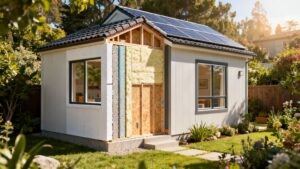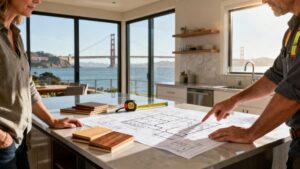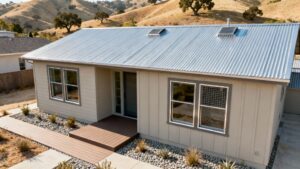If you own or build homes in the Bay Area—especially in the Berkeley and Oakland hills—making your house wildfire-resilient is smart. This guide gives clear, practical steps for “home hardening.” Choosing the right materials can greatly boost your home’s chance to survive a wildfire.
Why Wildfire Resilience Is a Smart Bay Area Investment

Wildfire season is a yearly reality for homeowners, contractors, architects, and remodelers in Berkeley, Oakland, San Francisco, and the greater Bay Area. Upgrades are no longer just about meeting code—they protect families, safeguard investments, and boost long-term property value.
According to the California Energy Commission, wildfire risk is rising in Wildland-Urban Interface (WUI) zones across our region. In San Francisco alone, over 92,000 homes are at moderate or greater risk, with a total reconstruction value exceeding $69.5 billion.
Investing in fire-resistant upgrades pays off by:
- Reducing the risk of total loss: Class A roofing, tempered-glass windows, and non-combustible siding stop embers from igniting.
- Earning possible insurance discounts: Many insurers reward homes that meet fire-safety standards.
- Raising property value: Buyers in high-risk areas prize wildfire-resilient certification.
Partnering with a local expert is key. Truitt & White offers fire-rated products, Bay Area building code know-how, and personalized support for builders and homeowners.
Prioritizing Your Upgrades From the Roof Down
Starting at the top and working down is the best strategy to harden a home. Your roof faces the most ember exposure, which can travel miles ahead of the main fire. If embers land on a flammable roof, the whole house is at risk.
Below is a quick guide to common weak points, their risks, and the best upgrades to fix them.
High-Impact Home Hardening Upgrades
| Home Component | Wildfire Risk | Recommended Resilient Upgrade | Primary Goal |
|---|---|---|---|
| Roof | High | Class A materials: metal, composite, or tile | Stop ignition from wind-blown embers. |
| Vents | High | 1/8-inch corrosion-resistant metal mesh screens | Block ember entry into attic and crawlspace. |
| Siding | Moderate | Fiber cement, stucco, or metal siding | Resist ignition from heat and direct flame. |
| Windows | Moderate | Dual-pane, tempered glass windows | Prevent breakage and ember entry. |
| Decks | Moderate-High | Non-combustible decking: composite or steel | Stop fire spreading from ground to house. |
| Gutters | High | Metal gutters with metal guards | Prevent ignition of leaves and debris. |
Start with a Class A Fire-Rated Roof
A Class A roof is your first line of defense. It withstands severe fire exposure and keeps embers from burning through to the roof deck. Top Bay Area options include:
- Composite Shingles: Fire-retardant granules give modern shingles a great mix of looks, durability, and cost.
- Concrete or Clay Tiles: Naturally non-combustible, they suit classic Bay Area styles.
- Standing-Seam Metal Roofing: Sheds pine needles and resists ember ignition. Check out the best metal roofing materials for ideas.
Roof upgrades aren’t just code—they’re the foundation of a smart, safe approach to protecting your home.
Secure Your Vents Against Ember Intrusion
Attic, soffit, and foundation vents are like open doors for embers. Standard screens are too wide to stop them. California code in WUI zones now requires vents to have corrosion-resistant metal screens with openings no larger than 1/8 inch.
This simple upgrade blocks embers and is cost-effective for every Bay Area home.
Don’t Overlook Gutters and Eaves
Eaves and gutters collect flammable debris—ember hotspots during wildfires. To protect your roofline:
- Install Metal Gutter Guards: Keep leaves and needles out.
- Choose Metal Gutters: Avoid vinyl, which can melt and drop flaming bits.
- Enclose Eaves: Fiber cement soffits close off exposed rafters, stopping ember traps.
Strengthening Your Walls, Windows, and Doors
After the roof and vents, focus on walls, windows, and doors. Radiant heat can ignite siding or shatter glass even without direct flames. In WUI zones around Oakland and Berkeley, non-combustible materials and fire-rated openings are essential.
Choosing Fire-Resistant Siding
Siding is your house’s largest vertical shield. Top Bay Area choices include:
- Fiber Cement Siding: Non-combustible, low-maintenance, and made to look like wood.
- Stucco: Traditional three-coat stucco offers excellent heat resistance when installed over a code-compliant barrier.
- Metal Siding: Corrugated or standing-seam panels add a modern look and won’t burn.
Think of siding as armor. Fiber cement is one of the single most effective upgrades against ember ignitions.
Fortifying Windows and Doors
Windows and doors are often the weakest links. Wildfire heat can break single-pane glass in minutes, opening your home to embers. Choose:
Windows
- Dual-Pane Tempered Glass: One pane must be temper-treated to resist shattering.
- Non-Combustible Frames: Fiberglass, aluminum, or reinforced vinyl frames won’t burn. Learn more about all-weather windows built to withstand the Bay Area.
Doors
- Solid-Core Wood Doors: Minimum 1-3/8 inches thick for fire resistance.
- Steel Doors: Non-combustible and highly protective.
- Fiberglass Doors: Mimic wood but resist fire.
Proper weather stripping and tight seals block embers and smoke leaks—key for energy savings and health. A study from BU.edu highlights serious health risks from wildfire smoke. Read more at discover more about the health impacts of wildfire smoke on BU.edu.
Creating Defensible Space Around Your Property
Wildfire resilience starts in the yard. Defensible space slows advancing flames and creates safer zones for firefighters. In Berkeley, Oakland, and other hillsides, zoning your landscape into three layers is the best approach.
| Zone (Distance) | Primary Goal | Key Actions |
|---|---|---|
| Zone 1 (0–5 Feet) | Ember Protection | Remove flammable debris; install non-combustible hardscaping |
| Zone 2 (5–30 Feet) | Fuel Reduction | Space plant “islands”; prune lower branches; choose fire-resistant plants |
| Zone 3 (30–100 Feet) | Thinning and Fuel Break | Remove dead material; thin canopies; clear leaf litter |
Zone 1 Ember-Resistant Zone (0–5 Feet)
This tight perimeter is your last line of defense.
• Clear Flammable Materials: Remove mulch, leaves, grasses, and combustible plants.
• Install Hardscaping: Use gravel, pavers, or concrete near foundations.
• Keep Under Decks Clear: Remove stored items and vegetation.
• Prune Overhead Limbs: Keep branches at least 10 feet from roofs and chimneys.
A non-combustible Ember-Resistant Zone buys precious time.

Zone 2 Lean, Clean, and Green Zone (5–30 Feet)
Here, limit fuel with strategic breaks.
• Group Plants in “Islands”: Avoid dense hedges.
• Prune Lower Branches: Lift to 6–10 feet.
• Choose Fire-Resistant Species: Lavender, sage, succulents thrive.
• Maintain Short Grass: Keep lawns under 4 inches.
Zone 3 Reduced Fuel Zone (30–100 Feet)
This outer ring eases fire intensity.
• Remove Dead Trees and Debris: Get rid of snags and leaf litter.
• Create Canopy Spacing: Leave 10 feet between tree crowns.
• Thin Underbrush: Reduce continuous fuel from ground to canopy.
Smart Material Choices for Fences and Decks
Attached elements can bridge fire to your home.
- Fences: Use metal or non-combustible materials for the first 5 feet. Explore 1 x 6 fence boards.
- Decks: Choose composite, steel, or concrete decking to stop flame travel.
Navigating Bay Area Codes and Finding the Right Products
Bay Area building codes in WUI zones are strict. Requirements vary by city and county. A knowledgeable local supplier makes code compliance simple, saving time and money.
Understanding WUI Codes and Product Ratings
Key terms to know when you shop:
- Class A Roof Covering: Highest fire-resistance for severe exposure.
- Ignition-Resistant Material: Lab-tested to withstand direct flame for a set time.
- Non-Combustible Material: Won’t burn—fiber cement, stucco, metal, concrete.
- Tempered Glass: Heat-treated to resist breaking under extreme heat.
Choosing properly rated materials isn’t just for passing inspections—it’s building a proven defense.
Sourcing Compliant Materials in the Bay Area
Big-box stores may lack local code–compliant products and expertise. A specialized Berkeley building materials supplier or lumberyard near Oakland offers:
- Expert Guidance: Local teams know your city’s WUI rules.
- Curated Inventory: Fire-rated products stocked for Bay Area needs.
- Manufacturer Partnerships: Access to top-tier brands like Marvin and Andersen.
For a complete permit checklist, see our guide to the building permit process. A trusted supplier turns complex regulations into clear steps.
Frequently Asked Questions
Where should I start my home-hardening project?
Begin with your roof and vents. Installing a Class A fire-rated roof and covering vents with 1/8-inch metal mesh closes the two biggest ember entry points.
Will these upgrades be too expensive in the Bay Area?
Costs vary, but integrating fire-resistant options into planned remodels often adds only a small premium. Prioritize high-impact upgrades like the roof and vents to spread costs over time.
Can wildfire upgrades lower my insurance premiums?
Yes. Many insurers offer discounts for homes meeting fire-safety standards. Document your upgrades and talk to your agent about requirements for savings.
How do I know if I’m in a WUI zone?
Check your city or county planning website for a Wildland-Urban Interface (WUI) map. If you’re unsure, local contractors and building supply experts can confirm your property’s status.
Can I do any of this work myself?
You can clear defensible space, clean gutters, and remove debris safely. Always hire a licensed professional for structural work like roofing, siding, and window or door installation to meet strict fire codes.
Where can I get more wildfire-resilient building advice?
The experts at Truitt & White are ready to help. For more questions, visit our own frequently asked questions.
Ready to start your wildfire-resilient home upgrade project? The experts at Truitt & White have the high-quality, code-compliant materials and local knowledge you need. Visit our Berkeley showroom for expert advice.









